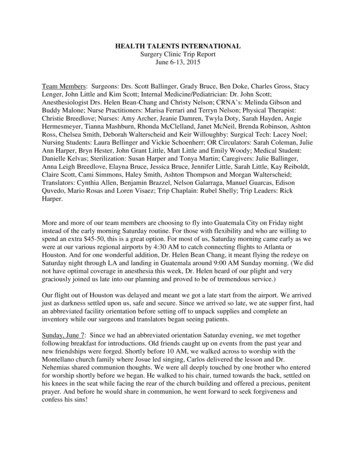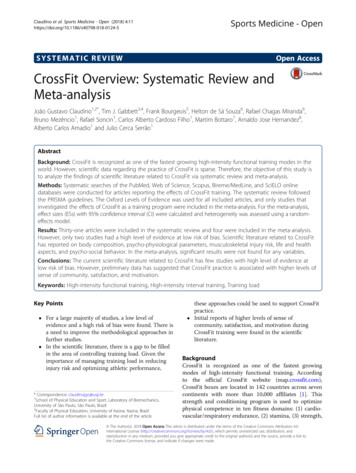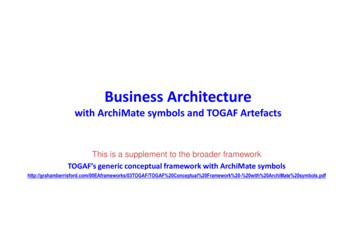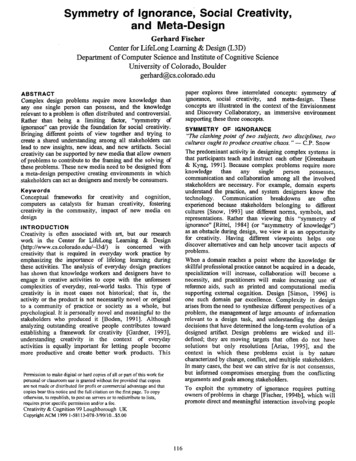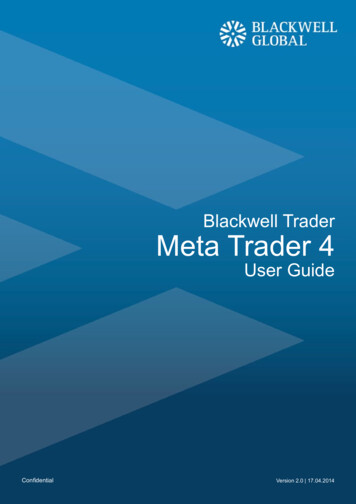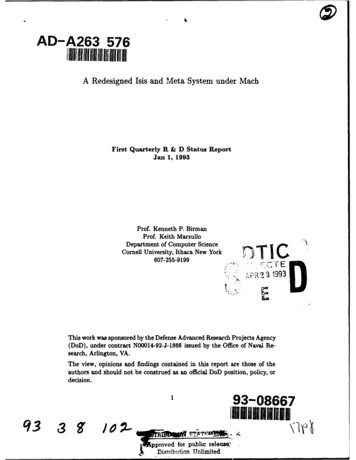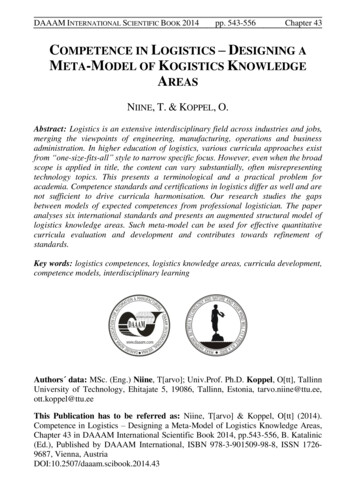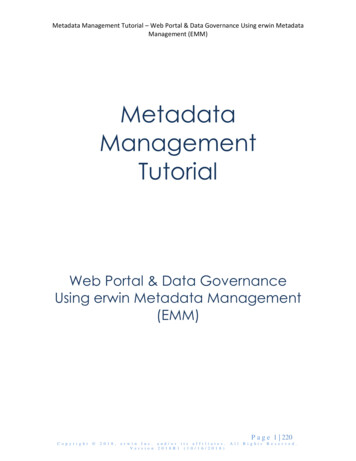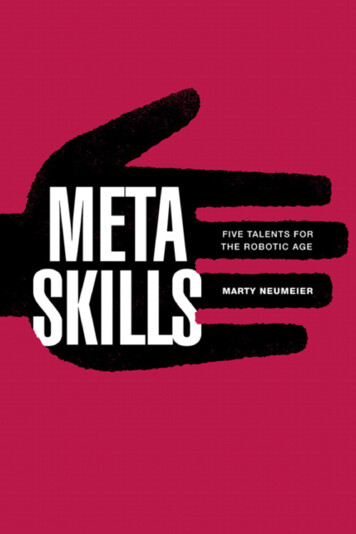
Transcription
CO NTE NT S
Preface I XAcknowledgements X IPrologue X I I ITen questions X V I IThere be dragons! 146A most unpleasant young manThe play instinct 154Dreaming together 163The bolt upright moment 16 8Six tests of originality 171TH E M A N DATEThe arc of human talent 2The innovation mandate 8Where are the jobs? 12The Robot Curve 15A crisis of happiness 20The obsolete industrial brain 24Wanted: Metaskills 27Congratulations, you’re a designerThe future in your hands 3 41504 MAKING30Il discorso mentale 177The no-process process 179Every day is Groundhog Day 182The discipline of uncluding 18 5The art of simplexity 191A reality check 194Sell in, not out 19 6The big to-do list 2011 FE E LI NGBrain surgery, self-taught 39When the right brain goes wrong 4 5The magical mind 49Leonardo’s assistant 54The uses of beauty 58Aesthetics for dummies 64It’s not business—it’s personal 74On what do you bias your opinion? 8 45 LE A R N I NGImpossible is nothing 207The joy zone 209What’s the mission? 213A theory of learning 217Climbing the bridge 220Creativity loves company 224Unplugging 226The scenic road to you 2282 SEEINGThe tyranny of or 91Thinking whole thoughts 95How systems work 98Grandma was right 103The primacy of purpose 116Sin explained 121The problem with solutions 126The art is in the framing 130A M O D E S T PRO P O S A LEpilogue 23 31. Shut down the factory 23 32. Change the subjects 23 53. Flip the classroom 2374. Stop talking, start making 2405. Engage the learning drive 2436. Advance beyond degrees 24 57. Shape the future 2473 DREAMINGBrilliant beyond reason 139The answer-shaped hole 14 3NotesIndex251275CONTENTSVII
PR E FAC E
What happens when a paradigm shifts? Do we simply wake up oneday and realize that the past seems irreversibly quaint? Or do financial institutions fail, governments topple, industries break down,and cultures crack in two, with one half pushing to go forward andthe other half pulling back?This is a book about personal mastery in a time of radicalchange. As we address our increasing problems with increasing collaboration, we’re finding that we still need something more—thebracing catalyst of individual genius.Unfortunately, our educational system has all but ruled outgenius. Instead of teaching us to create, it’s taught us to copy, memorize, obey, and keep score. Pretty much the same qualities we lookfor in machines. And now the machines are taking our jobs.I wrote this book to cut cubes out of clouds, put our swirl ofsocietal problems into some semblance of perspective, and suggesta new set of skills to address them. While the problems we facetoday can be a source of hand-wringing, they can also be a sourceof energy. They can either lead to societal gridlock or the mostspectacular explosion of creativity in human history.One thing’s for sure: There’s no going back, no secret exit, nochance of stopping the clock. The only way out is forward. Our besthope is that once we see the shape of our situation, we can turn ourunited attention to reshaping it. It won’t require a top-down strategy or an international fiat to get the transformation going. Just arelative handful of people—maybe people like you—with talent,vision, and a few modest tools.I’ve divided the book into seven parts. The first is about themandate for change. The next five are the metaskills you’ll need tomake a difference in the postindustrial workplace, including feeling, seeing, dreaming, making, and learning. The last is a set of suggestions for educational reform, written from the perspective of ahopeful observer.As you read about the metaskills, take comfort in the knowledge that no one needs to be strong in all five. It only takes one ortwo talents to create a genius.—Marty NeumeierPREFACEIX
DREAMING3
B R I LLI A N T B E YO N D R E A S O N . Imagination is one of the more mysterious capabilities of the human mind. How is it possible to conjure up images, feelings, or concepts that we can’t perceive throughour senses? How can we arrive at perfectly workable solutions without the benefit of logical thought? Is imagination learnable, or is itonly the preserve of eccentric artists and mad scientists?The metaskill of imagination is conspicuously absent from theeducational system. There are no classes called “Dreaming 101.”Alexander Graham Bell, arguably one of our more prolific inventors, seemed to be unaware of the role of imagination in his ownwork. He laid down three rules for innovation: 1) Observe as manyworthwhile facts as possible; 2) Remember what has been observed;3) Compare the facts so as to come to conclusions.Observe, remember, compare—then presto! —idea. Hello?Alex? Could there be anything missing between comparing andconcluding? Like maybe an insight? No disrespect to the telephone,but since when does the comparison of facts produce innovation?Let’s say I compared a number of worthwhile facts aboutsocial media. I observed the ways people use Facebook, noted theincrease in worldwide tweets, mapped the behavior of Pinterestusers, and measured the market for advertising potential and investor interest. Then I compared these facts. While I might find theminteresting, I would still need some insight, spark, or leap of imagination to out-innovate competitors who have access to the samefacts. Bell’s formula reminds me of the Monty Python skit in whicha man is interviewed about how to make a million pounds. “First,”he says, “get a million pounds.”When people talk about “dreaming up” an idea, they’re not farfrom the truth. Imagination is closely linked to dream states. Neuroscientists Charles Limb and Allen Braun studied the brains ofjazz musicians, revealing a “disassociated pattern of activity in theprefrontal cortex” when they played improvisational music. Theyfound it was absent when they played memorized sequences. Thesedisassociated patterns, they say, are similar to what happens inREM sleep. Dreaming is marked by a sense of unfocused attention,unplanned or irrational associations, and an apparent loss of con-DREAMING139
trol. When students exhibit this behavior in the classroom, teachers call it attention-deficit/hyperactivity disorder. When musiciansexhibit it, we call it genius.Dreams don’t simply visit us. We actively create them while we’reunconscious, not unlike the way we create our perceptions whilewe’re awake. What makes dreams so fascinating is the absence oflogical narrative. The word for dreaming in French is rêver—torave, to slip into madness. Even though the scenes we create in ourdreams may seem random or fantastical, their emotional trajectoryoften makes complete sense. Our emotions are fully engaged whileour reasoning is disconnected.What if we could harness this capability at will? Wouldn’t thisprovide the mental leap needed to connect the facts to a new conclusion? As it happens, there’s no other way to do it. Innovationneeds a little controlled madness, like the controlled explosions ofan internal combustion engine, to move it forward. Applied imagination is the ability to harness dreaming to a purpose. Innovators,then, are just practical dreamers.The encouraging news from science is that people who havethis talent are no smarter on average than other people. They’vesimply learned the “trick” of divergent thinking. Biographer WalterIsaacson described this quality in Steve Jobs: “Was he smart? No,not exceptionally. Instead, he was a genius. His imaginative leapswere instinctive, unexpected, and at times magical.” Jobs had theability to make connections that other people couldn’t see, simplybecause they couldn’t let go of what they already knew.In order to innovate, you need to move from the known to theunknown. You need to hold your beliefs lightly, so that what youbelieve doesn’t block your view of what you might find out. This ishard for most people. When asked to imagine a new tool for slicingbread, or a new format for a website, or a new melody for a song,they’ll stare blankly as if to say, “How could there be such a thing?”They may recall many of the knives, or the home pages, or popular songs they’ve known, but nothing new will come to mind. Atmost they might try to combine the features of two or more existing examples to come up with a hybrid.14 0M E TA S K I L L S
Originality isthe product ofimagination andknowledge.NEW TOTHEWORLDADAPTEDFROMTHE SAMEDOMAINADAPTEDFROMANOTHERDOMAINI M AG I N ATI O NNEW TOYOURSELFK N OW LE D G EDREAMING141
Why is this? What’s stopping us from using our imagination?We can only guess that our world of ready-made everything hasturned us into a population of idea shoppers. We expect to chooseour solutions off the rack instead of building them from scratch.We mix them and mash them, never believing that real originalityis within our power. And the companies that make our productsare not much different. They shop for best practices to make theirjobs easier, instead of imagining new practices that could set themapart or push them forward. Somewhere along the line we’ve lostour tolerance for trial and error, settling instead for the derivative,the dull, and the dis-integrated. We need to reverse this trend. Ifwe don’t, we’ll end up low on the Robot Curve.Originality doesn’t come from factual knowledge, nor does itcome from the suppression of factual knowledge. Instead, it comesfrom the exposure of factual knowledge to the animating force ofimagination. Depending on the quality of knowledge and the levelof imagination applied to it, an idea can fall into four categories: 1)an idea adapted from the same domain; 2) an idea adapted froma different domain; 3) an idea that is new to the innovator; 4) anidea that is new to the world. These are listed in ascending order,with “new to the world” being the rarest and most valuable. Thepath of learning starts with the more modest forms of originalityand leads to larger ones over time.Imagination is a renewable resource. It doesn’t get depleted byuse, but instead grows stronger with practice. WhenOriginality comesyou learn the trick of dreaming, of disassociatingfrom exposing factualyour thoughts from the linear and the logical, youknowledge to theanimating force ofcan become a wellspring of originality and brilliance.imagination.A client once asked architect Mark Kirkhart how hewas able to produce so many fresh concepts for a single building.He said: “I have ideas I haven’t even had yet.”Like all types of magic, dreaming is the result of practice. Thereare no shortcuts, only diversions and mental traps. In the followingchapters I’ll let you in on the hidden discipline that allows innovators to produce their acrobatic leaps of imagination.142M E TA S K I L L S
The number-one hazard for innovatorsis getting stuck in the tar pits of knowledge. Knowledge has a powerful influence over creativity. While it can free us to imagine newto-the-world ideas, it can also trap us into believing opportunitiesare smaller than they are. When we’re stumped by a problem, orwhen we feel hurried to solve it, our brains can easily default to offthe-shelf solutions based on “what everyone knows.” The problemsolving mind is a sucker for a pretty fact. But what we know todaymay not be what we need to know tomorrow, since every challengebrings with it new requirements for understanding.Arthur Conan Doyle, in the voice of Sherlock Holmes,expressed something similar when he said, “It is a capital mistaketo theorize before one has data. Insensibly, one begins to twist factsto suit theories, instead of theories to suit facts.” To avoid jumpingto conclusions, we need to hold off solving a problem until we canperceive the general shape of its solution. There are three steps ingenerating the answer to a problem: 1) discover what is; 2) imaginewhat could be; and 3) describe the attributes of success. Let’s takethem one by one.What is. This is the body of known facts about a problem. Whyis it a problem? What is its history? What is the conventional thinking about it? How have similar problems been solved in the past?In other domains? Other cultures? And what are the practical constraints of the problem?Constraints are the limitations imposed by the subject matter, or by the context, of a problem. They might have to do withbudgets, time, manpower, physics, habits, conventions, or humanfears. They squeeze the problem down to a size you can focus on.They force you to writhe uncomfortably in its grip while you struggle to break free. Without constraints, solutions tend towards theungainly, the unfocused, and the unimaginative. Unbounded challenges are anathema to innovators, draining their energy withoutdelivering insight. Bounded challenges provide not only a startingplace but a booster shot of adrenaline.Louis Pasteur, in a famous 1854 lecture at the University ofLille, said: “Dans les champs de l’observation, le hasard ne favorise queTH E A N SW E R - S H A PE D H O LE .DREAMING14 3
les esprit préparés.” In the field of observation, chance favors onlythe prepared mind. Pasteur’s statement is often used to supportthe idea that hard work trumps talent, but it also suggests that thebetter you understand the facts and constraints, the better yourchances of solving the problem.Without constraints,What could be. Facts and constraints are necessolutions tend toward theungainly, the unfocused,sary but insufficient. To envision what’s possible, youand the unimaginative.also need imagination. If innovation is determinedby what’s “useful, novel, and nonobvious,” as the US patent systemputs it, then you need ways to get beyond the obvious. One suchway is by asking deeper questions.For example, let’s say you run a marketing department in alarge company. The director of marketing, or perhaps the CEO,asks you to address declining revenues by improving the company’sadvertising. You could figure out how the existing campaign mightbe improved with stronger headlines, better product photography,or more precise targeting. Or you could go a little deeper and thinkabout the s
lar songs they’ve known, but nothing new will come to mind. At most they might try to combine the features of two or more exist-ing examples to come up with a hybrid. DREAMING 141 Originality is the product of imagination and knowledge. ADAPTED FROM ANOTHER DOMAIN ADAPTED FROM THE SAME DOMAIN NEW TO YOURSELF NEW TO THE WORLD KNOWLEDGE IMAGINATION. 142
